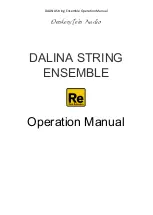
BASS MICRO SYNTHESIZER
Analog Bass Synthesizer
Congratulations on your purchase of the Electro-Harmonix XO Bass Micro Synth! You
have purchased a very powerful tool for musical expression. Please take a few
minutes to familiarize yourself with the Bass Micro Synth’s controls and how they
work
The XO BASS MICRO SYNTH can create many of the most popular analog lead
synthesizer textures at a fraction of the normal cost for such capabilities. Its four
voices: GUITAR, OCTAVE, SUB-OCTAVE, and SQUARE WAVE are completely
independent and fully mixable. The BASS MICRO SYNTH can modify these signals
with envelope control for a variety of “bowed” and “blown” sounds. In addition, a
sophisticated swept filter control allows highly variable frequency adjustments to be
made to the signal. When combined, these controls offer the user a creative
capability that is virtually limitless.
PREAMP GAIN ADJUSTMENT The preamp gain in the Bass Micro Synth has been set
at the factory for use with a bass equipped with single-coil passive pickups. If you will
be using another instrument with higher or lower output, it may be necessary to
readjust this setting. A screwdriver or alignment tool with a tip width of no more than
1/16" is required. To access the preamp gain adjustment, remove the bottom plate
from the Bass Micro Synth. Look for the small trim pot in the lower left corner of the
circuit board, it is labeled TRIM1 GAIN TRIM. Turning the trim pot clockwise will
increase the preamp gain. Turning it counter-clockwise will decrease preamp gain.
Please do not touch any other components when the bottom plate is removed or you
risk damaging the circuit board or the components.
OPERATION The Bass Micro Synth’s controls operate as described below. In all
cases, high-numbered control settings increase the level of the given effect.
FOOTSWITCH and Status LED – The Footswitch selects either effect mode or True
Bypass. When the Status LED is lit, the Bass Micro Synthesizer is in effect mode.
When the Status LED is off, the Bass Micro Synth is in True Bypass mode.
TRIGGER – Determines the input volume at which the filter circuits will “turn on.” It
does not affect any other circuitry. If the TRIGGER is set too high, the filter may
“stutter” due to multiple triggering. This is especially true if chords are played. It is
best to set the TRIGGER at exactly the sensitivity needed for your playing.
The next four controls of the BASS MICRO SYNTH comprise the VOICE MIXING
section: GUITAR, SUB-OCTAVE (one octave below), OCTAVE (one octave above), and
SQUARE WAVE. Each voice is completely independent and can be mixed with the
others in any degree. Please not the following voice characteristics:
GUITAR- Controls the output volume of the input signal through the filter.
SUB OCTAVE – Controls the output volume of the Sub-Octave. The Sub-Octave
effect only tracks single notes.
OCTAVE – Controls the output volume of the Octave. The Octave only tracks single
notes. This voice contains a small amount of harmonic distortion for added richness
of tone.
SQUARE WAVE – Controls the output volume of the Square wave. Intensity of this
voice is also determined by instrument attack or volume. In all other respects it
operates in a similar fashion to a standard distortion device.
ATTACK DELAY – Determines the time required for the voice signals to reach full
volume. Higher-numbered settings can completely remove the initial attack of the
instrument. Different delay times contribute greatly to the characteristic sounds of
various instruments. It is recommended that you synchronize your playing to the
speed setting of the ATTACK DELAY.
The final four controls comprise the FILTER SWEEP section.
RESONANCE – Affects the degree of sharpness, or “Q” of the filter. Higher settings
will produce a more emphasized filter sound and also add a slight boost to the signal.
START FREQUENCY - Determines the frequency at which the filter sweep begins.
STOP FREQUENCY – Determines the frequency at which the filter sweep ends. This
is also the “resting frequency” of the filter, and if the START and STOP controls are
set at the same level no sweep will occur, though the filter will provide emphasis of
that particular frequency band. In addition to lead synthesizer sounds, START and
STOP controls can be used to simulate attack, decay, and harmonic content of
acoustic instruments.
WARNING:
Your
Bass Micro Synth
comes equipped with
an
Electro-Harmonix 9.6DC-200BI
power supply
(same as used by Boss™ & Ibanez™ 9.6 Volts DC 200mA).
Use only the adaptor
supplied
. Using the wrong adapter can cause serious bodily injury. Using the wrong adapter
may also damage your unit and will void the warranty. In addition, do not use a daisy
chained supply with the Micro Synth. The Micro Synth must have its own power supply.
















